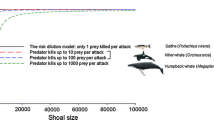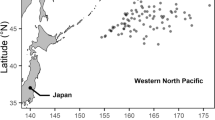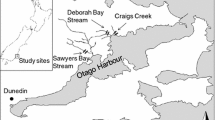Abstract
This paper extends theory of shoaling presented by Landa (1998), which uses the economic theory of clubs (Buchanan 1965). The findings include that non-patchy feeding shoals formed for defense increase in size with increased predation and decline in size with increased food concentration. There is strong evidence for the former and a piece of evidence for the latter. The size of shoals formed to find patches of food is unaffected by food availability. When defense is also involved, increasing predation increases shoal size and increasing food availability decreases shoal size. The optimum size of migrating schools—synchronized and polarized swimming shoals—is often the whole population migrating, explaining the mammoth size of some schools. Further, mergers of schools are forecast along the migration route with larger schools at the end of the route than at the beginning. When there is no defense motive for shoaling, non-patchy feeders may form large schools under low food density and be solitary under high food density. Small schools might not be found. When there is also a defense motivation for shoaling, small schools are possible. For schools formed among patchy feeders, increased food availability decreases school size. The same finding holds for schooling among patchy feeders where an added shoal benefit is defense. Also under these circumstances, increased predation increases shoal size.
Similar content being viewed by others
References
Amesbury S. S., Myers R. F. (1982) The fishes, guide to the coastal resources of Guam (Vol. 1). University of Guam Press, Mangilao, Guam
Anderson J. J. (1981) A stochastic model for the size of fish schools. Fisheries Bulletin 79(2): 315–323
Barber, I., & Huntingford, F. A. (1996). Parasite infection alters schooling behavior: Deviant positioning of helminth-infected minnows in conspecific groups. Proceedings of Royal Society, London, 263, 1095–1102.
Berner T. O., Grubb T. C. Jr. (1985) An experimental analysis of mixed-species flocking in birds of deciduous woodland. Ecology 66: 1229–1236
Bleckmann H. (1993) Role of the lateral line in fish behavior. In: Pitcher T. J. (eds) The behavior of teleost fishes, 2nd ed. Chapman and Hall, London, pp 211–246
Breder C. M. Jr. (1967) On the survival value of fish schools. Zoologica 52: 25–40
Brown G. E. (2003) Learning about danger: Chemical alarm cues a local risk assessment in prey fishes. Fish and Fisheries 4(3): 227–234
Brown C., Laland K. N. (2003) Social learning in fishes: A review. Fish and Fisheries 4(3): 280–288
Buchanan J. M. (1965) An economic theory of clubs. Economica 32: 1–14
Caraco T., Wolf L. L. (1975) Ecological determinants of group sizes of foraging lions. The American Naturalist 109(967): 343–352
Clark C. W. (1987) The lazy, adaptable lions: A Markovian model of group foraging. Animal Behaviour 35: 361–368
Clark C. W., Mangel M. M. (1984) Foraging and flocking strategies: Information in an uncertain environment. The American Naturalist 123: 625–641
Clark C. W., Mangel M. M. (1986) The evolutionary advantages of group foraging. Theoretical Population Biology 30: 45–75
Cosmides L., Tooby J. M. (1994) Better than rational: Evolutionary psychology and the invisible hand. The American Economic Review 84: 327–332
Davis M. W., Olla B. L. (1994) The role of visual cues in the facilitation of growth in a schooling fish. Environmental Biology of Fishes 34(4): 421–424
Dawkins R. (1989) The selfish gene. Oxford University Press, Oxford
Dawkins R., Krebs J. R. (1979) Arms races between and within species. Proceedings of the Royal Society of London Series B 205: 489–511
Deng, J., & Shao, X. M. (2006). Hydrodynamics in a diamond-shaped fish school. Journal of Hydrodynamics Series B, 18(3, Supplement 1), 438–442.
Dill L. M. (1987) Animal decision making and its ecological consequences: The future of aquatic ecology and behavior. Canadian Journal of Zoology 65: 803–811
Duffy D. C., Wissel C. (1988) Models of fish school size in relation to environmental productivity. Ecological Modeling 40: 201–211
Eggers D. M. (1976) Theoretical effect of schooling by planktivorous predators on rate of prey consumption. Journal of Fish Resource Board Canada 33: 1964–1971
Flierl G., Grűnbaum D., Levin S., Olson D. (1999) From individuals to aggregations: The interplay between behavior and physics. Journal of Theoretical Biology 196: 397–454
Foster W. A., Treherne J. E. (1981) Evidence for the dilution effect in the selfish herd from fish predation on a marine insect. Nature 293: 466–467
Griffiths S. W. (2003) Learned recognition by conspecifics by fishes. Fish and Fisheries 4(3): 256–268
Grubb T. C. Jr. (1987) Changes in the flocking behaviour of wintering English titmice with time, weather and supplementary food. Animal Behaviour 35: 794–806
Hamilton W. D. (1971) Geometry for the selfish herd. Journal of Theoretical Biology 31: 295–311
Hara T. J. (1993) Role of olfaction in fish behavior. In: Pitcher T. J. (eds) The behavior of teleost fishes, 2nd ed. Chapman & Hall, London, pp 171–197
Hart P. J. B. (1993) Teleost foraging: Facts and theories. In: Pitcher T. J. (eds) The behavior of teleost fishes, 2nd ed. Chapman & Hall, London, pp 253–284
Helfman G. S. (1993) Fish behavior by day, night and twilight. In: Pitcher T. J. (eds) The behavior of teleost fishes, 2nd ed. Chapman & Hall, London, pp 479–512
Huntington F. A. (1993) Development of behavior in fish. In: Pitcher T. J. (eds) The behavior of teleost fishes, 2nd ed. Chapman & Hall, London, pp 57–93
Kelly J. L. (2003) Learning predator recognition and antipredator responses. Fishes 4(3): 216–226
Krause J., Godin J.-G. J., Brown David (1996) Phenotypic variability within and between fish shoals. Ecology 77(5): 1586–1591
Krause J., Hoare D.J., Croft D., Lawrence J., Ward A., Ruxton G.D., Godin J.-G. J., James R. (2000) Fish shoal composition: Mechanisms and constraints. Proceedings the Royal Society 267: 2011–2016
Laland K. N., Brown C. (2003) Learning in fishes: From three-second memory to culture. Fish and Fisheries 4(3): 199–204
Landa J. T. (1998) Bioeconomics of schooling fishes: Selfish fish, quasi-free riders, and other fishy tales. Environmental Biology of Fishes 53: 353–364
Liao J. C., Beal D. N., Lauder G. V., Triantafyilou M. S. (2003) Fish exploiting vortices decrease muscle activity. Science 302: 1566–1569
Lobban C. S., Schefter M. (1997) Tropical pacific island environments. University of Guam Press, Mangilao, Guam
Magurran A. E., Pitcher T. J. (1983) Foraging, timidity and shoal size in Minnows and goldfish. Behavioral Ecology and Sociobiology 12: 147–152
Mangel M. M., Clark C. W. (1986) Towards a unified foraging theory. Ecology 67(5): 1137–1138
Mayer, P. C. (2005). Property Rights and resource management among nonhuman species. In American Law & Economics Association 15th annual meeting, Working Paper 47. http://waw.bepressw.com/alea/15th/alrt47 or search ‘Peter C. Mayer’ Property Rights.
McNamara J. M., Houston A. I. (1986) The currency for behavioral decisions. The American Naturalist 127(3): 358–378
Mikheev V. N., Pasternak A. F. (2006) Defense behavior of fish against predators and parasites. Journal of Ichthyology 46(Supplement 2): S173–S179
Milinski M. (1993) Predation risk and feeding behavior. In: Pitcher T. J. (eds) The behavior of teleost fishes, 2nd ed. Chapman & Hall, London, pp 285–305
Morocha P., Lauffer R. (1994) Look again, animal disguises. Compass Productions, Long Beach, CA
Partridge B. L. (1982) The structure and function of fish schools. Scientific American 246(2): 114–123
Pitcher T. J. (1983) Heuristic definition of fish shoaling behaviour. Animal Behaviour 31(2): 611–613
Pitcher T. J. (1986) Functions of shoaling behavior in teleosts. In: Pitcher T. J. (eds) The behavior of teleost fishes, 1st ed. Johns Hopkins University Press, Baltimore, pp 204–337
Pitcher T. J., Magurran A. E., Winfield I. J. (1982) Fish in larger shoals find food faster. Behavioral Ecology and Sociobiology 10: 149–151
Pitcher T. J., Parrish J. K. (1993) Functions of shoaling behavior in teleosts. In: Pitcher T. J. (eds) The behavior of teleost fishes, 2nd ed. Chapman & Hall, London, pp 363–427
Pool R. (1995) Putting game theory to the test. Science 267: 1591–1593
Pulliam H. R., Caraco T. (1984) Living in groups: Is there an optimal group size?. In: Krebs J. R., Davies N. B. (eds) Behavioral ecology, 2nd ed. Blackwell, Oxford, pp 122–147
Ripley. (5, November 1995). Ripley’s believe it or not. In Pacific Sunday News, Vol. 26, p. 277. Agana, Guam. from United Feature Syndicates, Inc.
Roare D. J., Krause J. (2003) Social organization, shoal structure and information transfer. Fish and Fisheries 4(3): 269–279
Ryer C. H., Olla B. L. (1991) Agonistic behavior in a schooling fish: Form, function and ontogeny. Environmental Biology of Fishes 31: 355–363
Shaw E. (1978) Schooling fish. American Scientist 66: 166–175
Sibly R. M. (1983) Optimal group size is unstable. Animal Behaviour 31: 947–948
Taylor R. J. (1984) Predation. Chapman and Hall, New York/London
The Economist. (December 25, 1993–January 7, 1994). Evo-economics: Biology meets the dismal science, pp. 93–95.
Treisman M. (1975) Predation and the evolution of gregariousness. I. Models for concealment and evasion. Animal Behaviour 23: 779–800
Warburton K. (2003) Learning of foraging skills by fish. Fish and Fisheries 4(3): 203–215
Ward, A. J. W., Botham, M. S., Hoare, D. J., James, R., Broom, M., Godin, J.-G. J., & Krause, J. (2002). Association patterns and shoal fidelity in the three-spined stickleback. Proceedings Royal Society, 269, 2451–2455.
Weihs D. (1973) Hydromechanics of fish schooling. Nature 241: 290–291
Weihs D. (1975) Some hydrodynamical aspects of fish schooling. In: Wu T. Y. T., Brokaw C. J., Brennen C. (eds) Swimming and flying in nature. Plenum Press, New York, pp 703–718
Weihs D., Webb P. M. (1983) Optimization of locomotion. In: Weihs D., Webb P. W. (eds) Fish biomechanics. Praeger Press, New York, pp 339–371
Wilson M. (2006) Acoustic-waveguide sonar finds enormous fish shoals. Physics Today 59(4): 20–26
Author information
Authors and Affiliations
Corresponding author
Rights and permissions
About this article
Cite this article
Mayer, P.C. Economic models of fish shoal (school) size: a near comprehensive view of single species shoaling strategy. J Bioecon 12, 119–143 (2010). https://doi.org/10.1007/s10818-010-9084-7
Published:
Issue Date:
DOI: https://doi.org/10.1007/s10818-010-9084-7
Keywords
- Flock
- Herd
- Optimum shoal size
- Defense
- Food patches
- Collective good
- Free-riding
- Comparative static analysis
- Marginal




